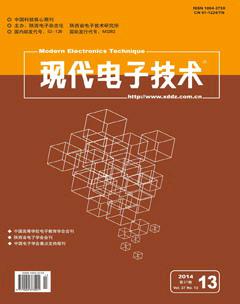基于基函数分解的连续变速颤振边界预测方法
谭博+郑华+裴承鸣
摘 要: 针对连续变速颤振试验实测信号的特点及在线处理需求,提出一种基于基函数展开的时变参数建模方法。通过对结构响应信号建模和稳定性判据的趋势分析,得到颤振边界随时间变化的预测曲线。依据颤振试验机理,采用白噪声激励多模态耦合系统的方式生成了相应的仿真信号,进而在不同信噪比下验证了方法的数值性能。最后通过气弹模型低速风洞试验进一步检验本文方法的工程实用性。
关键词: 连续变速颤振试验; 基函数; 时变参数建模; 颤振边界预测
中图分类号: TN911.7?34; TP391.9 文献标识码: A 文章编号: 1004?373X(2014)13?0047?03
Method for progression variable speed flutter boundary prediction
based on basis function decomposition
TAN Bo, ZHENG Hua, PEI Cheng?ming
(Data Processing Center, Northwestern Polytechnical University, Xian 710072, China)
Abstract: According to the characteristics and online processing requirements of the actual measuring signal in flutter test with progression variable speed (FTPVS), a time?varying parameter modeling algorithm based on basis function expansion is presented in this paper. The prediction curves of flutter boundary versus time variation were obtained on the basis of modeling of structural response signal and trend analysis of the stability criterion. According to the mechanism of flutter test, the correspon?ding simulation signal is generated with the mode that the white noise stimulates the multi?modal coupling system. The numerical performance of the method was verified at different SNRs. The practical applicability of the method was checked in aeroelastic model wind?tunnel test.
Keywords: flutter test with progression variable speed; basis function; time?varying parameter modeling; flutter boundary prediction
0 引 言
连续变速颤振试验是近年来从飞机结构强度专业角度提出的一种全新颤振试验概念,指由于研究对象的实际工作状态或试验方法的需要,马赫数、速度、高度等参数连续变化的一类颤振试验技术。与传统的台阶式颤振试验方法相比,具有试验周期短、试验开支小、技术约束少、更符合实际使用状态等优势,但同时也存在更大的试验风险[4]。因此,在试验中能否基于实测信号快速准确地完成颤振边界预测是保证该类试验安全有效的关键技术之一。
连续变速颤振试验的结构响应信号是非平稳随机过程,这一特点使得传统的颤振试验数据处理方法难以直接应用。因此,本文提出一种基于基函数展开的时变参数建模方法,通过实测信号建立测试对象的时变参数模型,从而提取信号中所蕴含的稳定性特征量,并根据该特征量的趋势进行外推分析,以获取每个时刻的颤振边界预测值,为试验过程的实时监控及试验安全提供技术保障。
1 方法简述
在平稳系统模型建立中,非时变随机信号可以看作是线性系统的白噪声激励响应,如下式:
[y(n)=-k=1paky(n-k)+k=0qbku(n-k)] (1)
式中:[y(n)]为非时变随机信号;[u(n)]为系统的白噪声激励。
相应的,由于在连续变速颤振试验中,试验对象的结构模态参数会随时间发生变化,因此,对公式(1)中的系数进行改变,即可得到时变线性系统的参数模型,表示为:
[y(n)=-k=1pak(n)y(n-k)+k=0qbk(n)u(n-k)] (2)
公式(2)也被称为非平稳随机信号的时变自回归滑动平均模型。若系数[bk(n)=0, k=1,2,3,…,]则模型变为非平稳随机信号的时变自回归模型(TVAR)。
类似于平稳系统模型的建立,时变随机信号可以看作非平稳线性系统的白噪声激励响应,在实际应用中,通常采用时变自回归模型,由公式⑵可以得到TVAR的参数模型为:
[y(n)=-k=1pak(n)y(n-k)+u(n)] (3)
式中:[y(n)]是时变随机信号;[p]是模型阶数;[ak(n)]是时变AR系数;[u(n)]是白噪声激励。
为求解时变AR系数,将[ak(n)]用函数空间基函数的加权和表示为:
[ak(n)=i=0mbkifi(n)] (4)
式中:[bki]为加权系数;[fi(n)]为选定函数空间的基函数;[m]为函数空间的维数。
相应的TVAR模型公式变为:
[y(n)=-k=1pi=0mbki[fi(n)y(n-k)]+u(n)] (5)
定义矢量[Y(N-k)]和[θ:]
[Y(N-k)=[f0(n)y(n-k),…,fm(n)y(n-k)]] (6)
[θ=[a10,…,a1m,…,ap0,…,qpm]] (7)
这时,TVAR模型的矩阵形式为:
[y(n)=-[Y(N-1),…,Y(n-p)]θT+u(n)] (8)
由此,将线性时变AR系数[ak(n)]的求解转化成为求解线性时不变系统的加权系数向量[θ]的问题。解出[θ]后,结合选定函数空间的基函数[fi(n),]由公式(4)即可得到所建模型的时变AR系数。
本文选择傅里叶基函数对时变AR系数进行求解,其构造公式为:
[fk(n)=coskπn2N,k为偶数sin(k+1)πn2N,k为奇数] (9)
由解得的时变AR系数[ak(n),]可以提取[n]时刻的稳定性判据,如Jury判据,Lyapunov判据以及阻尼比系数等。依据[n]时刻对应的速度值,以曲线拟合的方式对颤振边界进行预测。
2 仿真试验及结果
根据典型结构颤振机理及其响应信号特征,采用白噪声激励时变系统生成的仿真信号来测试本文方法的数值性能。
不排除一般性,典型的颤振现象往往在两阶结构模态耦合时出现,为此,模拟连续变速颤振响应信号可由以下系统生成:
[x(t)=i=1nAie-ξi(t)fi(t)2πtcos2πfi(t)1-ξ2i(t)t] (10)
式中:[n]为模态个数;[f]为频率;[ξ]为阻尼比。在0时刻,各参数的初值分别为:[f1=]10 Hz,[f2=]20 Hz,[v=0,][ξ1=0.11,ξ2=0.1。]
为了模拟颤振发生过程,在归一化速度线性增加的情况下,两阶模态的频率逐渐靠拢直至完全重合,而阻尼比则逐渐衰减至零。经过64 s运行后仿真系统发生颤振,在采样频率为128 Hz情况下得到长度为8 192的随机响应信号,此时对应的频率为[f1=f2=]15 Hz,相应的阻尼比系数为[ξ1=ξ2=0,]归一化颤振速度为[v=1。]
在上述条件下生成的无噪声仿真信号的时间历程如图1所示,相应的联合时频分布如图2所示。
图1 仿真信号的时间历程
图2 仿真信号的联合时频图
应用本文方法对无噪声干扰的仿真信号进行颤振边界外推计算,所得结果如图3所示。图中,纵轴为速度,[v=1]的直线标示了颤振边界的真值,横轴为时间。由图3可以看出,在无噪声的情况下,本文方法计算的外推值从时刻[n=40]开始快速上升在[n=50]时到达真实值[v=1,]在其后的时间内,外推值在真值附近小幅波动,也就是说可以快速得到准确稳定的颤振边界预测值。
为了进一步测试本文方法在噪声环境下的数值性能,定义信噪比:
[SNR=10×logPsignalPnoise] (11)
式中:[P]为信号的功率,在此定义下,计算并得到了信噪比分别为20 dB,14 dB,10 dB和8 dB的外推值曲线,如图4所示。
图3 无噪声环境的颤振边界预测结果
图4 噪声环境下颤振边界预测结果
由图4可以看出,信噪比为20 dB时,外推值曲线尽管随时间变化的趋势有少许不同,但还是在[n=50]左右达到了真实值。当信噪比下降到14 dB时,外推值趋势与无噪声情况类似,但最终外推值在到达[v=]1.2附近时才趋于稳定,颤振边界预测值的精度也有所下降。若信噪比进一步降低,可以看到外推值的平稳趋势开始消失,所得的外推结果已经不宜在试验中作为参考。由此可见,本文方法对噪声相对敏感。为此,在实际应用中应尽可能保证测试、采集、记录等响应信号获取过程各环节的质量。
3 试验数据处理
为了验证所研究方法的工程实用性,先后进行了多次物理试验。作为举例,这里仅给出一组试验结果。
试验数据取自某飞机气弹模型低速风洞试验,对应试验状态由传统台阶等速试验得到的颤振临界速度为40.8 m/s。
实测信号的时间历程及对应的试验风速变化曲线如图5所示。
图5 连续变速颤振试验实测数据
由图5可见,选取的实测信号对应的风速以近似于线性增长的方式,经过29 s从25 m/s提升至38 m/s。采用本文方法对该段实测数据进行处理,所求的颤振边界预测值曲线如图6所示。
图6 实测数据的颤振边界预测结果
由图6可以看出,本文方法的计算结果,于20 s左右达到了颤振临界速度[v=]40.8 m/s附近,并趋于平稳。此时对应的速度为[v=]35 m/s,距离颤振速度尚有较大的安全空间。这表明,本文方法在连续变速颤振试验中,可以对颤振边界进行有效预测,并且保留了较大的安全裕量。
4 结 论
本文研究了基于基函数展开的时变参数建模方法及其在连续变速颤振试验中的应用问题。通过数值仿真,验证并分析了方法的精度及抗噪性能。结果表明,该方法在较高信噪比下,可以得到满意的预测值,但其精度会随信噪比的减小而下降。而气弹模型风洞试验的应用结果表明,该方法完全可以满足工程实际的物理需求。
本文研究为丰富和扩展连续变速颤振试验的在线监控方法提供了一种新的手段,在航空、航天、导弹、亚太空等领域的结构颤振试验方面有着潜在的应用前景。
参考文献
[1] COWAN T J, ARENA A S, GUPTA K K. Accelerating CFD?based aero elastic predictions using system identification [R/OL]. [2010?01?02]. http://www. citeseerx.ist.psu.edu.
[2] NAMARA J J, FRIEDMANN P P. Flutter boundary identification for time?domain computational aero elasticity [J]. American Institute of Aeronautics and Astronautics. 2007, 45(7): 1546?1554.
[3] MAHER Damien, Combined time and frequency domain approaches to the operational identification of vehicle suspension [D]. Ireland: School of Mechanical and Manufacturing Engineering, Dublin City University, 2011.
[4] Garrick I E, Reed W H. Historical development of aircraft flutter [J]. Journal of Aircraft, 1981, 18(11): 897?912.
[5] BAE J, KIM J, LEE I, et al. Extension of flutter prediction parameter for multimode flutter systems [J] Journal of Aircraft, 2005, 42(1): 285?288.
[6] MATSUZAKI Y, TORII H. Flutter boundary prediction of an adaptive smart wing during process of adaptation using steady?state response data [C]// 47th AIAA/ASME/ASCE/AHS/ASC Structures, Structural Dynamics and Materials Conference. Newport, RI: AIAA, 2006: 2132?2139.
[7] THURUTHIMATTAM, B J, FRIEDMANN P P, MCNAMARA J J, et al. Modeling approaches to hypersonic aerothermoelasticity with application to reusable launch vehicles [C]// 44th AIAA/ASME/ASCE/AHS Structures, Structural Dynamics and Materials Conference. Norfolk, VA: AIAA, 2003: 1967?1977.
[8] 朝伦巴根,贾德彬.数值计算方法[M].北京:中国水利水电出版社,2006.
[9] 王宏禹.非平稳随机信号分析与处理[M].北京:国防工业出版社,1999.
[10] 林青,戴慧珺,马文涛.基于正交基函数神经网络的图像加密算法仿真[J].计算机仿真,2013,30(10):416?421.
参考文献
[1] COWAN T J, ARENA A S, GUPTA K K. Accelerating CFD?based aero elastic predictions using system identification [R/OL]. [2010?01?02]. http://www. citeseerx.ist.psu.edu.
[2] NAMARA J J, FRIEDMANN P P. Flutter boundary identification for time?domain computational aero elasticity [J]. American Institute of Aeronautics and Astronautics. 2007, 45(7): 1546?1554.
[3] MAHER Damien, Combined time and frequency domain approaches to the operational identification of vehicle suspension [D]. Ireland: School of Mechanical and Manufacturing Engineering, Dublin City University, 2011.
[4] Garrick I E, Reed W H. Historical development of aircraft flutter [J]. Journal of Aircraft, 1981, 18(11): 897?912.
[5] BAE J, KIM J, LEE I, et al. Extension of flutter prediction parameter for multimode flutter systems [J] Journal of Aircraft, 2005, 42(1): 285?288.
[6] MATSUZAKI Y, TORII H. Flutter boundary prediction of an adaptive smart wing during process of adaptation using steady?state response data [C]// 47th AIAA/ASME/ASCE/AHS/ASC Structures, Structural Dynamics and Materials Conference. Newport, RI: AIAA, 2006: 2132?2139.
[7] THURUTHIMATTAM, B J, FRIEDMANN P P, MCNAMARA J J, et al. Modeling approaches to hypersonic aerothermoelasticity with application to reusable launch vehicles [C]// 44th AIAA/ASME/ASCE/AHS Structures, Structural Dynamics and Materials Conference. Norfolk, VA: AIAA, 2003: 1967?1977.
[8] 朝伦巴根,贾德彬.数值计算方法[M].北京:中国水利水电出版社,2006.
[9] 王宏禹.非平稳随机信号分析与处理[M].北京:国防工业出版社,1999.
[10] 林青,戴慧珺,马文涛.基于正交基函数神经网络的图像加密算法仿真[J].计算机仿真,2013,30(10):416?421.
参考文献
[1] COWAN T J, ARENA A S, GUPTA K K. Accelerating CFD?based aero elastic predictions using system identification [R/OL]. [2010?01?02]. http://www. citeseerx.ist.psu.edu.
[2] NAMARA J J, FRIEDMANN P P. Flutter boundary identification for time?domain computational aero elasticity [J]. American Institute of Aeronautics and Astronautics. 2007, 45(7): 1546?1554.
[3] MAHER Damien, Combined time and frequency domain approaches to the operational identification of vehicle suspension [D]. Ireland: School of Mechanical and Manufacturing Engineering, Dublin City University, 2011.
[4] Garrick I E, Reed W H. Historical development of aircraft flutter [J]. Journal of Aircraft, 1981, 18(11): 897?912.
[5] BAE J, KIM J, LEE I, et al. Extension of flutter prediction parameter for multimode flutter systems [J] Journal of Aircraft, 2005, 42(1): 285?288.
[6] MATSUZAKI Y, TORII H. Flutter boundary prediction of an adaptive smart wing during process of adaptation using steady?state response data [C]// 47th AIAA/ASME/ASCE/AHS/ASC Structures, Structural Dynamics and Materials Conference. Newport, RI: AIAA, 2006: 2132?2139.
[7] THURUTHIMATTAM, B J, FRIEDMANN P P, MCNAMARA J J, et al. Modeling approaches to hypersonic aerothermoelasticity with application to reusable launch vehicles [C]// 44th AIAA/ASME/ASCE/AHS Structures, Structural Dynamics and Materials Conference. Norfolk, VA: AIAA, 2003: 1967?1977.
[8] 朝伦巴根,贾德彬.数值计算方法[M].北京:中国水利水电出版社,2006.
[9] 王宏禹.非平稳随机信号分析与处理[M].北京:国防工业出版社,1999.
[10] 林青,戴慧珺,马文涛.基于正交基函数神经网络的图像加密算法仿真[J].计算机仿真,2013,30(10):416?421.

